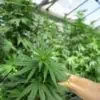TABLE OF CONTENTS
Plants need a healthy root system to survive and prosper. Pathogens can attack roots and rapidly spread throughout the garden.
There are three common variations of cannabis root disease that often cripple cannabis gardens.
Different Types of Cannabis Root Disease
Fusarium
There are a wide variety of species of fusarium. Fusarium inhabits soil. It is often used to destroy cannabis and coco plants by governments.
The damage is most evident on the stems and leaves of the marijuana plant. It affects the roots first and then makes it way up the plant.
Growers often notice curled leaf tips, dark spots on lower leaves, and wilted and dry looking leaves. The stems will turn yellow at first and eventually become brown. Once they are brown they will soon die.
How To Prevent and Control Fusarium
-If growing outdoors, once fusarium is found in the soil, the area is no longer useable for growing cannabis. The fusarium will stay dormant in the ground for years and wait for the right time to attack.
-Use compost in the soil to help prevent fungal infections
-Put the plants in containers instead of directly in the soil.
-Remove affected plants from the garden and wash all the tools that were used with hydrogen peroxide.
Pythium
Pythium is a parasitic root fungus that causes major damage to plants. It can multiply quickly and infect the roots of cannabis plants. Pythium likes to attack young cannabis plants, seeds or seedlings.
Pythium is sometimes referred to as a “secondary infection”, because it often attacks plant that have already been weakened by some form of stress, such as pests, nutrient deficiencies, or disease. If your plants look wilted, yellow in color, with brown leaf edges you may have pythium in your garden.
How To Prevent and Control Pythium
-Keep the garden free of pests and disease
-Use compost tea to help keep the soil healthy
-Keep fungus gnats from entering the garden since fungus gnats can carry pythium spores
Verticillium Wilt
Verticillium wilt is caused by the presence of fungi in poorly drained soils. Lower leaves will turn yellow, as well between the veins on the stalk, at the first sign of verticillium wilt.
It must be dealt with immediately. Any infected plant material and growing media should be carefully removed from the garden. Verticillium wilt spores can remain viable in soil for many years.
How To Prevent and Control Verticillium Wilt
-Unfortunately there is no cure for verticillium wilt.
-Prevention is the best and only method.
-If growing outdoors, try to rotate the crop and add compost to the soil
-Make sure the plant beds are properly drained
Stem Rots-Damping Off
Damping off, or stem rot, is a reaction to a disease. Roots, seeds and seedlings are attacked by soil born fungi causing the delivery of nutrients to the plant to be thwarted.
The result is mushy, damp, soft stems. This will cause the plant to fall over and die.
Damping off starts below the soil line. The first sign is when the lower portion of the stalk becomes discolored, usually yellow or brown. Eventually the stem will turn brown and soft then it will fall over dead.
Damping off usually affects seedlings first since they are young and frail.
How To Prevent and Control Root Rot-Damping Off
-Add compost tea to the soil
-Do not overwater the plants. Only water when the soil is dry.
“
There are over 300,000 jobs in the cannabis industry. CTU trained me for one of them!

Makes $24.50 @ THC +
-Do not transplant seedlings until they have multiple sets of leaves so they are strong enough to avoid shock.
-Spray the soil with a copper-based anti-fungal treatment
-Always sterilize tools after each use
To learn all about cannabis diseases and to get instruction on how to grow weed, and how to set up an entire hydroponic garden, go to Cannabis Training University.

Luis Cordova
Luis Cordova is a distinguished author, and renowned expert in cannabis cultivation, who possesses a Master's degree in Plant Biotechnology and Pharmaceutical Science. As a valued contributor to highly esteemed publications such as Cannabis Training University and Maximum Yield Magazine, Luis has emerged as a trusted source of guidance and knowledge in the cannabis industry. Having written thousands of informative articles, Luis is widely recognized for his comprehensive expertise on cultivating cannabis, both indoors and outdoors.












 Jeff was involved in an accident where he endured a traumatic brain injury. He had a week-long stay in ICU where brain surgeons
Jeff was involved in an accident where he endured a traumatic brain injury. He had a week-long stay in ICU where brain surgeons  100% risk free money back guarantee within 48 hours after purchase if student has not completed any of the courses or exams.
100% risk free money back guarantee within 48 hours after purchase if student has not completed any of the courses or exams.